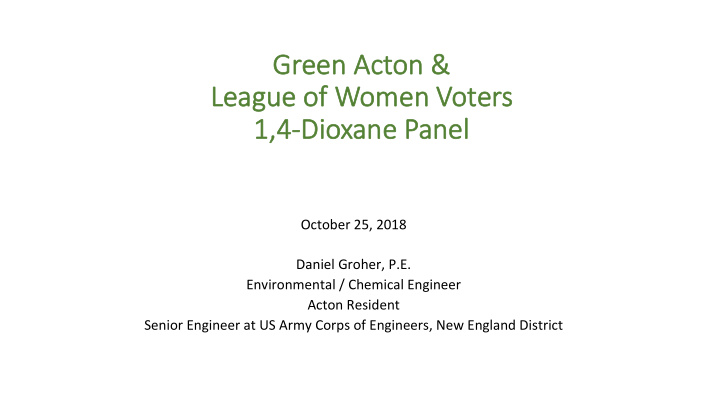



Gr Green een Act Acton on & & League of Wome men Voters 1,4-Dioxane P 1,4-Dio ane Panel anel October 25, 2018 Daniel Groher, P.E. Environmental / Chemical Engineer Acton Resident Senior Engineer at US Army Corps of Engineers, New England District
Outline – – Groundwater Protection/Treatme ment • How 1,4-dioxane got into OUR drinking water wells • How to keep it out of our wells? Two steps: • Pumping to intercept the contaminated GW before it gets close to our wells. • Treat the residual source material that continually “bleeds” in to the GW way upgradient at the NMI site. • What happens to the water when it gets pumped out of the ground (“extracted” from the ground)?
1,4-Dio 1,4-Dioxane ane [ From:https://www.epa.gov/sites/production/ files/2014-03/documents/ ffrro_factsheet_contaminant_14-]dioxane_januar y2014_final.pdf] “1,4-Dioxane is a synthetic cyclic ether generally found at sites in association with releases of chlorinated solvents, especially 1,1,1-TCA. 1,4-dioxane is highly miscible in water, mixing with water so readily that it can be found in groundwater plumes far in advance of any solvents with which it was originally released. It also migrates rapidly in soil and can readily leach into groundwater. 1,4-dioxane does not adsorb significantly to suspended sediments and is relatively resistant to biodegradation. Volatilization occurs relatively rapidly from dry soils, but relatively slowly from surface water.”
“Id “Idea ealized ed” Gr ” Graphic of a c of a Dr Drinki king W Water er Pr Prod oduct ction on W Wel ell Drinking Water Well – (e.g., Assabet 1)
Ho How d w do w o we p e prot otect ect Drin Drinkin king W g Water W er Wells? ells? • There are normally a variety of options; but with 1,4-dioxane contamination there are few • There are no reliable in-situ treatment options (i.e., hard to treat the water while it is in the ground) • Typical approaches are: • intercept the contamination before it reaches the drinking water wells • treat the drinking water before enters distribution system • (Talk about other possibilities in a minute…)
“Cartoon” of plume me interception Town Intercepted water water Dioxane from NMI
NMI / Cone of Concord depression Drawdown pumping water level Plume before EW-1 installed and pumping
NMI / Cone of Concord depression Drawdown pumping water level Intended effect of pumping EW-1
DATA FROM JUNE 2018 Plume seems to be starting to bifurcate
Wha What happens t t happens to the gr the groundw undwater when it er when it gets extracted (pump mped) from m the ground? • Normally, there are a variety of methods available for treating toxic organic compounds in groundwater (GW) • For example, for a long time at W.R. Grace they extracted GW contaminated by solvents and treated it above ground by: • “stripping” the solvent compounds out of the GW into air • then using a carbon filter to “pull” the solvents out of the air • This is a very common way to treat volatile organic compounds in GW • Another common approach is to pass water directly through a liquid-phase carbon filter bed • Then the treated water is discharged… somewhere
Ho How ar w are t e they t y trea eatin ing t g the gr e grou oundwater er pump mped from m EW-1? • The “normal” methods don’t work well for 1,4-dioxane: it’s chemistry makes it want to be in water much more than air or on carbon • While searching for the best approach, water has been treated by liquid-phase carbon filtration, and discharged to the Assabet River • Carbon is removing ~ 45% of the dioxane (average discharge less then 10 µg/l) • “Final” method pilot tested and selected for the NMI plume water is a destructive method called “UV advanced oxidation”
UV UV A Adv dvanc anced O ed Oxida idatio tion Pr n Process (A ess (AOP) P) • EPA intention is for system to remove 95% of dioxane in influent • UV-AOP adds a chemical oxidant (persulfate) to the extracted water and then ultraviolet light to destroy the dioxane • Products are sulfate, CO 2 and water • Pilot testing achieved removal to “non-detect” (< 0.15 µg/l) • System will have 6 reactors to allow for increased flow in the future
When do When does it all s es it all stop? p? Wha What abo t about the So ut the Sour urce? ce? • EPA is requiring groundwater cleanup to 0.46 µg/l 1,4-dioxane • Source area appears to be the bedrock below NMI site • 1,4-dioxane is migrating very slowly from bedrock to overburden • Future will either be: • Install extraction well(s) in bedrock source area and try to remove all of the dioxane à will take a VERY long time • Inject reactant (e.g., persulfate chemical oxidant) into injection wells to destroy dioxane in-situ à no proven track record for dioxane in bedrock • There have been recent advances in bioremediation of dioxane in preliminary tests, but not at low concentrations in bedrock. • Time and more research may provide answers!!
Recommend
More recommend